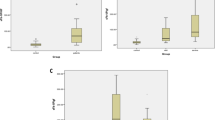Abstract
Introduction
Preeclampsia is a leading cause of maternal and perinatal mortality and morbidity, but signs and symptoms are non-specific and may vary. The root cause is imbalance of circulating angiogenic factors of placental (syncytiotrophoblast) origin, with consequent low levels of placental growth factor (PlGF) which may aid in diagnosis and prediction of disease.
Aims and Objectives
To study the incidence of women at risk of developing early-onset preeclampsia by plasma placental growth factor biomarker assay in high-risk patients, to assess the maternal outcome in patients with PlGF values below cutoff for presenting gestational age, to calculate sensitivity, specificity, positive predictive value and negative predictive value of PlGF assay in predicting preeclampsia and to conclude whether PlGF biomarker assay can be an effective screening test in high-risk patients for prediction of early-onset preeclampsia.
Materials and Methods
The study was carried out in the Department of Obstetrics and Gynecology at a tertiary care center. It is a prospective study, and study period extended from April 2012 to October 2013. One hundred pregnant women with 20- to 34-week gestational age with possible high risk of developing preeclampsia attending the antenatal clinics and high-risk OPDs were screened in the present study after explaining the nature of the study. PLGF concentration was quantitated using plasma and processed in Triage kit device (fluorescence immunoassay device). PLGF concentration was categorized against a specific range for specific gestation, and values below the range or <12 pg/ml were considered screened positives. The cases were followed up till delivery.
Results
Twenty-two cases were screened positive, of which 20 developed preeclampsia with a strong positive prediction value of more than 90 %.
Conclusion
PLGF is a strong predictor and a useful assay for early-onset preeclampsia.

Similar content being viewed by others
References
Menzies J, Magee LA, Macnab YC, et al. Current CHS and NHBPEP criteria for severe preeclampsia do not uniformly predict adverse maternal or perinatal outcomes. Hypertens Pregnancy. 2007;26:447–62.
Sibai BM. Diagnosis, controversies, and management of the syndrome of hemolysis, elevated liver enzymes, and low platelet count. Obstet Gynecol. 2004;103:981–91.
Magee LA, von Dadelszen P, Chan S, et al. The control of hypertension in pregnancy study pilot trial. BJOG. 2007;114:770.e13–20.
Chappell LC, Duckworth S, Seed PT, et al. Diagnostic accuracy of placental growth factor in women with suspected preeclampsia: a prospective multicenter study. Circulation. 2013. doi:10.1161/CIRCULATIONAHA.113.003215.
Maynard S, Min J, Merchan J, et al. Excess placental soluble FMS-like tyrosine kinase 1 (sFlt1) may contribute to endothelial dysfunction, hypertension, and proteinuria in preeclampsia. J Clin Invest. 2003;111:649–58.
Venkatesha A, Toporsian M, Lam C, et al. Soluble endoglin contributes to the pathogenesis of preeclampsia. Nat Med. 2006;12:642–9.
Levine R, Lam C, Qian C, et al. Soluble endoglin and other circulating antiangiogenic factors in preeclampsia. N Engl J Med. 2006;355:992–1005.
Taylor R, Grimwood J, Taylor R, et al. Longitudinal serum concentrations of placental growth factor: evidence for abnormal placental angiogenesis in pathologic pregnancies. Am J Obstet Gynecol. 2003;188:177–82.
Buhimschi C, Norwitz E, Funai E, et al. Urinary angiogenic factors cluster hypertensive disorders and identify women with severe preeclampsia. Am J Obstet Gynecol. 2005;192:734–41.
Levine R, Maynard S, Qian C, et al. Circulating angiogenic factors and the risk of preeclampsia. N Engl J Med. 2004;350:672–82.
Wikstrom A, Larsson A, Eriksson U, et al. Placental growth factor and soluble fms-like tyrosine kinase-1 in early-onset and late-onset preeclampsia. Obstet Gynecol. 2007;109:1368–74.
Romero R, Nien J, Espinoza J, et al. A longitudinal study of angiogenic (placental growth factor) and anti-angiogenic (soluble endoglin and soluble vascular endothelial growth factor receptor-1) factors in normal pregnancy and patients destined to develop preeclampsia and deliver a small for gestational neonate. J Matern Fetal Neonatal Med. 2008;21:9–23.
Ohkuchi A, Hirashima C, Matsubara S, et al. Alterations in placental growth factor levels before and after the onset of preeclampsia are more pronounced in women with early onset severe preeclampsia. Hypertens Res. 2007;30:151–9.
Benton SJ, Hu Y, Xie F, et al. Angiogenic factors as diagnostic tests for preeclampsia: a performance comparison between two commercial immunoassays. Am J Obstet Gynecol. 2011;205:469.e1–8.
Sharon Maynard Annu. Rev. Med. 2008.59:61–78. Downloaded from arjournals.annualreviews.org by Mr Paul Sheard on 03/19/08.
Triage® PLGF Test Product Insert.2011.
Sibai BM. Hypertension. In: Gabbe SG, Niebyl JR, Galen H, et al., editors. Obstetrics: Normal and problem pregnancies. 6th ed. New York: Elsevier; 2012. p. 779–822.
Hirashima C, Ohkuchi A, Arai F, et al. Establishing reference values for both total soluble Fms-like tyrosine kinase 1 and free placental growth factor in pregnant women. Hypertens Res. 2005;28:727–32.
Cnossen JS, ter Riet G, Mol BW, et al. Are tests for predicting pre-eclampsia good enough to make screening viable? A review of reviews and critical appraisal. Acta Obstet Gynecol Scand. 2009;88:758–65.
Verlohren S, Galindo A, Schlembach D, et al. An automated method for the determination of the sFlt-1/PlGF ratio in the assessment of preeclampsia. Am J Obstet Gynecol. 2009;201:e1–11.
Knudsen UB, Kronbog CS, von Dadelszen P, et al. Pregnancy hypertension: an international Journal of Women’s Cardiovascular. Health. 2012;2:8–15.
Author information
Authors and Affiliations
Corresponding author
Ethics declarations
Conflict of interest
Authors declare that they have no conflict of interest.
Ethical Approval
The study was approved by the research ethics committee of the institution. All the procedures followed were in accordance with the ethical standards.
Additional information
Pooja Mathur Third Year; Poonam Mathur Assistant Professor; Laxmi Maru Prof & Head of Department; Anupama Dave Associate Professor Department of Obstetrics & Gynecology Maharaja Yashwant Rao Hospital & MGM Medical College Indore.
Rights and permissions
About this article
Cite this article
Mathur, P., Mathur, P., Maru, L. et al. A Prospective Study of Placental Growth Factor Assay as a Novel Biomarker in Predicting Early-Onset Preeclampsia in High-Risk Patients. J Obstet Gynecol India 66 (Suppl 1), 98–103 (2016). https://doi.org/10.1007/s13224-015-0793-7
Received:
Accepted:
Published:
Issue Date:
DOI: https://doi.org/10.1007/s13224-015-0793-7




